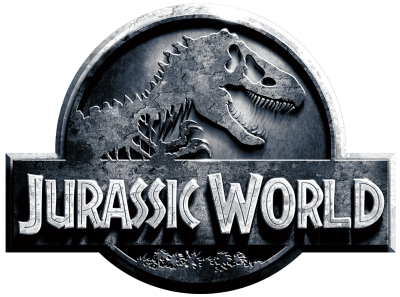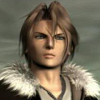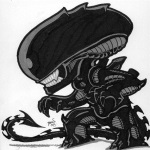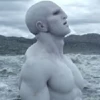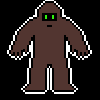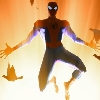 AllosaurusMember4115 XPNov-06-2018 11:55 AM
AllosaurusMember4115 XPNov-06-2018 11:55 AMPart Eight: Early Jurassic, 193 MYA
The dinosaurs have spread across the globe, diversifying into many forms. One of these is Sarahsaurus. She’s a plant-eater, a basal sauropodomorph. She will become the sauropods, the largest land animals of all time. The lower vegetation is consumed by plant-eaters like Scutellosaurus. His kin will give rise to thyreophorans like Stegosaurus and Ankylosaurus. The future sauropods and Thyreophorans will become larger than these primitive forms. But where there are herbivores, there are also carnivores.
Coelophysis bauri of the Triassic has evolved into C.kayentakatae. They’re still swift, agile predators, but Scutellosaurus is too well-protected for them, and Sarahsaurus is too large. Without a carnivore to eat the herbivores, they would overeat the vegetation and consume the vegetation, decreasing the amount of oxygen in the air. Luckily, Coelophysis aren’t the largest theropods anymore.
Enter Dilophosaurus wetherilli. While Coelophysis lacks the power to dispatch a Sarahsaurus, Dilophosaurus is fit for this task. She and her mate surround one of the herbivores. Although she’s bigger than the predators, she’s not big enough to be invulnerable. The male Dilophosaurus lunges for the neck, forcing her down as the female uses her four-fingered hands to slash at the herbivore’s flanks. This is the end for one dinosaur. But Sarahsaurus and its kin will survive. They’ll become larger, big enough to dwarf their prey.
Part Nine: Late Jurassic, 150 MYA
Sarahsaurus and its relatives will give rise to the sauropods, which include the largest dinosaur of all time: Barosaurus lentus, a giant with masses ranging from 100 to 120 tons. This mother is laying her eggs at the edge of a forest. Once she’s laid them all, she uses her massive feet to cover them in dirt, covering them beneath the ground. She then leaves them to her fate; all she can do is hope they survive.
Months later, the eggs finally hatch. The little Barosaurus hatchlings poke their little heads out of the ground. This is the first time they’re seeing this Jurassic world. They’re blank slates who don’t know its dangers. Although they will grow into hundred-ton giants, for now, they’re small and vulnerable. They slowly crawl out of the spot where their eggs were laid. One particular Barosaurus instinctively knows to head deeper into the forest for protection, and her siblings follow. Their skin pattern, along with the dense vegetation, will help keep them hidden from predators like the approaching Ceratosaurus, a descendant of Dilophosaurus. Most of the little sauropods make it into a thick bush. One lags behind, however--and makes a snack for the hungry predator.
The Ceratosaurus leaves the forest, knowing that he'll find larger prey in the open prairies. The remaining Barosaurus infants immediately begin to eat the lush forest vegetation. If they're going to grow to a hundred tons, they need to eat a substantial amount of food. They spend most of the day feeding. For years, they stay in the forest as they grow larger. Once they're big enough, they'll leave the wooded area and look for a herd of adults.
*7 years later*
The Barosaurus are now juveniles, but the forest is becoming too cramped for them. They'll have to go out to the prairies, which are dry and arid. The female leads the remaining two individuals outside the forest. They're astonished by the dinosaurs they see. Apatosaurus and Diplodocus feed on low-lying plants, using stones to help grind the vegetation in their stomachs. Brachiosaurus reach to the top of trees, stripping them of leaves.
Despite not being adults, the Barosaurus are large enough that carnivores won't attack them...alone. Two Allosaurus are stalking them. These predators are widespread across the world, especially here in Colorado. The pair keep their distance; size isn't the sauropods’ only defense. Their tails have a whip-like end that could easily snap the neck of a predator.
The sauropod trio pass by one of the most famous inhabitants of the Jurassic: Stegosaurus, a seven-ton herbivore with bad attitude who just wants to be left alone. He doesn't mind herbivores, but he's hostile towards carnivores like the two Allosaurus. The theropods growl at him as his instincts tell him to defend himself. He flushes blood into his back plates, causing them to turn bright colors. As a warning, he swings his tail--which bears four lethal spikes known as a thagomizer.
The predators know better than to stand their ground. They slowly back down. Not every day needs to have an epic battle.
The Stegosaurus has unwittingly and unintentionally allowed the Barosaurus to get a head start on the Allosaurs. But they won't give up on finding food. Dinosaurs are everywhere in this world.
*3 years later*
The trio of Barosaurus are drinking at a lake when they hear a familiar sound: the gentle call of other Barosaurus. The three release calls in response, making the herd aware of their presence. As the herd arrives, the calls continue until the juveniles are allowed in the herd. It's the dry season, so the herd is migrating to wetter areas.
As a result of their size, Barosaurus are incredibly slow. They also need to eat whenever they can to sustain their massive bulk. Their greatest challenge also awaits them: crossing a vast salt plain with no food or water. In this area, Allosaurus congregate together for the annual migration of the Barosaurus. These hunting groups are temporary and have no social hierarchy.
*A week into the migration*
The herd is nearing the end of the salt plain, and they can practically taste the water on the other side. However, they have company; a pack of Allosaurus have united for a hunt. They plan on making a kill together, but they'll disband soon after.
The sight of the first Allosaurus causes the herd to flee. But with their massive size, they don't get very far. The largest individuals of the herd are virtually invulnerable because they're simply too large for the Allosaurs. The juveniles are a little faster, but more vulnerable.
The group of Allosaurus weaves in and out between the sauropods using their speed and agility. They're trying to separate one of the juveniles from the herd. They lock onto their target: the youngest of the trio of juveniles. He gets flanked by two of the predators as the herd moves on. They're at the edge of the salt plain--and near a small drop. It's lethal for the Barosaurus.
The four Allosaurus snap their jaws and make fake lunges. The unintelligent herbivore backs up, slipping over the edge. He moans in pain as the carnivores jump down and sink their teeth into his flesh. The carcass will keep them fed for days, but they may not have the time to enjoy it; a larger predator arrives. Enter Saurophaganax maximus. Although he may look similar to Allosaurus, he's nearly twice the size. He's the bully of the Jurassic.
The larger Allosaur hisses at his species’ smaller relatives. The Allosaurus back up as the Saurophaganax begins to tear into the carcass.
*Many years later*
The same female Barosaurus from all those years ago is finally laying her eggs. She digs a hole in the ground with her massive feet. Then, squatting, she lays five eggs before covering them up with soil. She walks off as a Saurophaganax watches.
***
The sauropods would continue to diversify, forming a group called the Titanosaurs. Allosaurus, Saurophaganax, and their kind would form the Carcharodontosaurs. Next time in Life, we will explore the lost world of Africa, and meet one of the most bizarre dinosaurs of all time.
"Part of the journey is the end..."
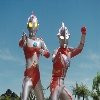 StegosaurusMember934 XP2018-11-06 18:56:00
StegosaurusMember934 XP2018-11-06 18:56:00That was great. I liked the part with the Dilophosaurus.
Godzilla... Truly a God incarnate.
